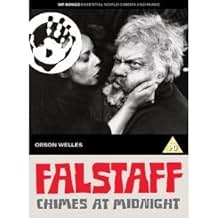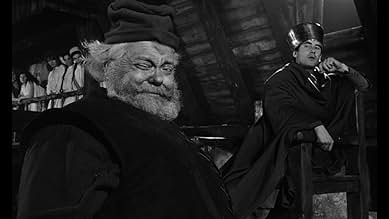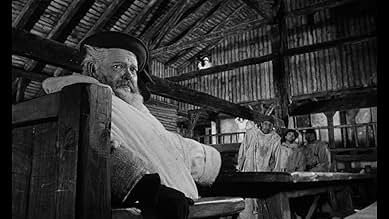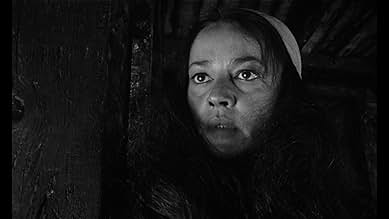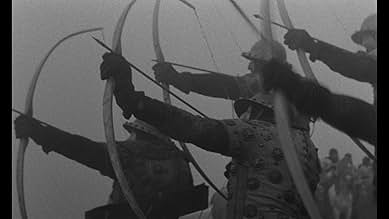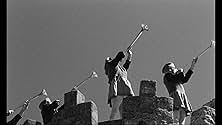La carrera del personaje Sir John Falstaff de Shakespeare, como compañero del joven príncipe Hal, desde 1400 a 1413.La carrera del personaje Sir John Falstaff de Shakespeare, como compañero del joven príncipe Hal, desde 1400 a 1413.La carrera del personaje Sir John Falstaff de Shakespeare, como compañero del joven príncipe Hal, desde 1400 a 1413.
- Nominado a 1 premio BAFTA
- 3 premios y 2 nominaciones en total
- Pistol
- (as Michael Aldrich)
- Woman's Tailor
- (as Andres Mejuto)
- Northumberland
- (as Jose Nieto)
Argumento
¿Sabías que...?
- CuriosidadesDespite portraying Falstaff as a grossly obese man, Orson Welles actually had to diet to slim down for the role.
- PifiasThe corpse of Hotspur opens and closes his mouth several minutes after his death.
- Citas
Falstaff: My King! My Jove! I speak to thee my heart!
Henry V: I know thee not, old man. Fall to thy prayers. How ill white hairs becomes a fool and jester. I have long dreamed of such a kind of man, so surfeit-swelled, so old, and so profane. But being awaked, I do despise my dream. Make less thy body hence and more thy grace. Leave gormandizing; know the grave doth gape for thee thrice wider than for other men.
[Falstaff laughs and rises]
Henry V: Reply not to me with a fool-born jest! Presume not that I am the thing I was.
- ConexionesFeatured in The 43rd Annual Academy Awards (1971)
Welles is possibly not a perfect Falstaff - failing to some degree to capture the character's jovial humour - but he gives a good performance in a limited, but powerfully melancholy vein. Keith Baxter makes Hal very much his own, providing curious contrasts to both of his father figures. Gielgud is as sublime as ever, and his scenes are beautifully directed - one wouldn't know the problems Welles had in terms of actor availability, considering how effective the medium close camera-work is.
The poetry of the "Sleep" speech is absolutely overpowering in Gielgud's rendition, and his facial expressions, eyes cast in shadow, are perfectly haunting. The strength of his performance is crucial; Henry IV is thus very much a figure with dignity but guilt and a coldness matching the stone of his solitary court - brilliant use of some sort of cathedral. Margaret Rutherford and Tony Beckley certainly add a lot to the mix, as does the bizarrely ill-fitting Jeanne Moreau, that most French of actresses playing an English whore. The tenderness she feels for Falstaff is crucial in softening his character a bit; Moreau's bedraggled siren works as a necessary example of the femininity of the Tavern, as compared to the masculine world of battle and court that Falstaff is so lost in. What a striking actress she is here; piercing, soulful eyes, such lips and flowing dark hair. It is a skittish and perfect performance fitting in with Welles' fantasia of "Merrie England". That most of this was filmed in Spain conveys the sense of this as an artificial, beyond-reality dream of the Paradise Lost. The film can effectively be seen as Welles expressing his interest in Western society's mourning a lost golden age - in this case, "Merrie England", which Falstaff embodies. The rational and dulling technocracy of the future is suggested by the coldness of Gielgud and Baxter towards the end, and the atmosphere of court.
The actor playing Justice Shallow is supremely odd and bewitching in his shrill little voice; his blustering humour and reminiscence taking on much melancholy as the film moves inexorably towards its tragic, deathly close. The scene where Falstaff finds out Hal is now King, is wonderfully shown in long shot by a still camera; a depression and drift towards disillusion shown. When Falstaff finds out, the lift in spirits is conveyed with his movement towards the camera. It's a return to the general sense of camera mobility around Falstaff - contrasting with the stillness around Bolingbroke. The final rejection of Falstaff that follows is beautifully filmed by Welles, played ambiguously by Baxter and movingly by Welles.
What must be the most remarkable sequence is the Battle of Shrewsbury; it is this that will haunt the mind long into the ether... Savage, indiscriminate quickness of brutal death emphasised in quick cuts. The fighting is impersonal and grimly realistic; ranks of silhouetted men and horses charging in, arrows - unlike in Olivier's "Henry V" - being shown cascading into and piercing ranks of horses and soldiers. The dry ground dissolves gradually to mud, and a haunting, holy-sounding piece of choral music strikes a chilling note of ironic contrast. Mankind has been reduced by war back to the very mud from which it originally arose. All sense of 'glory' is dissipated and cut away, by this frightening, near-ten minute sequence. It is one of the most gripping, utterly transcendent and powerful sequences I have seen in the whole of my film viewing.
"Chimes at Midnight" is a marvel of a film; this is a Welles film in its true form and not tampered with - "The Magnificent Ambersons" is the most shameful previous example of this. "Chimes..." stands as a complex masterpiece; partly an elegy for an innocence than may never have truly existed, but which Welles *feels* deeply. Track this down if you can as it is something special; let's hope it is soon restored to the best possible condition. It is wonderfully slanted Shakespeare; history plays fashioned into a tragedy, and painted from the most compelling cinematic palette. And above all, it is wonderful Welles.
- HenryHextonEsq
- 4 jun 2003
- Enlace permanente
Selecciones populares
- How long is Chimes at Midnight?Con tecnología de Alexa
Detalles
- Fecha de lanzamiento
- Países de origen
- Idioma
- Títulos en diferentes países
- Campanades a mitjanit
- Localizaciones del rodaje
- Pedraza, Segovia, Castilla y León, España(London streets scenes)
- Empresas productoras
- Ver más compañías en los créditos en IMDbPro
Taquilla
- Presupuesto
- 800.000 US$ (estimación)
- Recaudación en Estados Unidos y Canadá
- 126.724 US$
- Fin de semana de estreno en EE. UU. y Canadá
- 13.630 US$
- 3 ene 2016
- Recaudación en todo el mundo
- 126.724 US$
- Duración1 hora 53 minutos
- Color
- Mezcla de sonido
- Relación de aspecto
- 1.66 : 1
Contribuir a esta página




